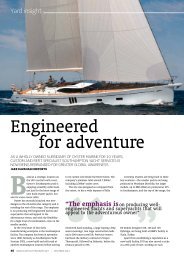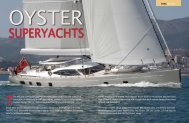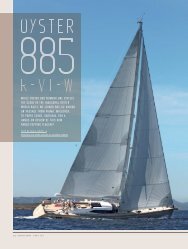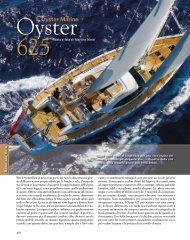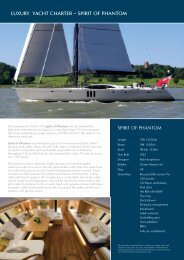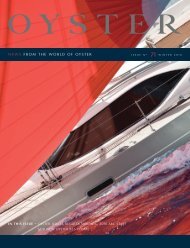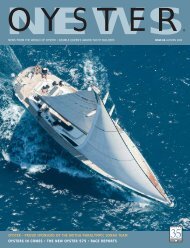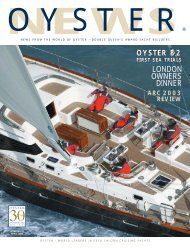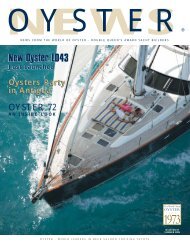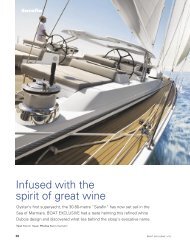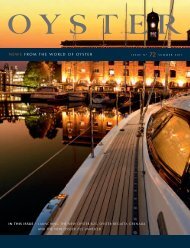Create successful ePaper yourself
Turn your PDF publications into a flip-book with our unique Google optimized e-Paper software.
‘ When he was told<br />
it would take him 20<br />
years at Eastman Kodak<br />
to become a vice<br />
president, he left and<br />
joined The Hallmark Card<br />
Company where he was<br />
asked to run the<br />
computer programming<br />
division. The fact that he<br />
knew little about<br />
computers didn’t stop<br />
him. He learned<br />
’<br />
24 www.oystermarine.com<br />
They both hasten to say they dated other<br />
people through high school, but the die<br />
was cast when they first met and they<br />
both knew it. They have been best friends<br />
ever since.<br />
The two of them quietly planned Bob’s<br />
retirement in 1997, confirming it by placing<br />
an order for an <strong>Oyster</strong> 485.<br />
Why an <strong>Oyster</strong>? They wanted a "real blue<br />
water boat" for extensive cruising. <strong>Oyster</strong>’s<br />
big deck saloon windows that provide a<br />
light, open feeling below was a factor, and<br />
they liked <strong>Oyster</strong>’s reputation for aftersales<br />
service (little did they know they<br />
would give that reputation the acid test).<br />
The 485 was the biggest boat they thought<br />
the two of them could handle.<br />
A year or so later their boat was ready, and<br />
among the charges was a $50,000 bill for<br />
shipping the boat to the United States. Jan<br />
Crandall suggested the much less<br />
expensive plan of sailing the boat across the<br />
Atlantic. "After all, it is a sailboat," she had<br />
said. "And it would be a great adventure."<br />
Bob agreed, although neither of them had<br />
spent as much as one night offshore. But<br />
they had sailed a lot, first in a 25-foot daysailor,<br />
then cruising for ten years on a C&C<br />
35. "Yes, crossing the pond was a big jump,<br />
but no matter," Bob Crandall says with a<br />
shrug. "Sailing is sailing."<br />
Jan says Bob’s retirement had something<br />
to do with her suggestion. "I couldn’t<br />
imagine how Day One of retirement would<br />
go when Bob asked, `Well what do I do<br />
now?’ So we gave him something to do<br />
that required his full attention."<br />
While looking at a sister 485 during the<br />
search for the right boat, the Crandalls had<br />
met Martin Tate, a professional sailor who<br />
was doing after-sales and commissioning<br />
work for <strong>Oyster</strong> at the time. Tate is a salty<br />
bloke from Yorkshire, England, who has<br />
sailed since childhood. He’s crossed the<br />
Atlantic three times single-handed;<br />
voyages he doesn’t feel are worth talking<br />
about. "It’s a personal thing," he says in a<br />
rich, North Country accent. "I’m a sailor. I<br />
just did it. If the truth were known, I<br />
couldn’t afford the airfare."<br />
The Crandalls liked the cut of Tate’s jib,<br />
and signed him up for the transatlantic<br />
passage. On May 20, 1998, the Crandalls<br />
left Dallas/Fort Worth airport after a<br />
rousing send off by thousands of American<br />
employees lining the taxiway, and with<br />
water cannons dousing their aircraft. They<br />
flew to Ipswich, Suffolk, boarded the boat<br />
they had christened Arway at Fox’s<br />
Marina, where <strong>Oyster</strong> Marine is located,<br />
and four days later they set sail. Their<br />
route took them into the North Sea,<br />
through Dover Straits, and west through<br />
the English Channel. For Jan, it was the<br />
worst part of the trip. They bobbed about<br />
like a cork most of their first night out.<br />
Then it started to blow. "Oh I didn’t like<br />
England," she says with a shiver. "Wind<br />
and waves were on the nose, I was half<br />
sick and frozen...I remember thinking,<br />
`Why did I volunteer for this?’"<br />
After a stop in Southampton to have the<br />
radar repaired, they set course for the<br />
Azores. With just three people on board,<br />
devising a good watch system is a<br />
challenge. Tate would go off for a nap at 4<br />
pm. At 6 pm, Jan would make sandwiches<br />
to be eaten during the night, and then go off<br />
watch. Martin would relieve Bob at 10 pm<br />
and stand until 2 am alone, when both Jan<br />
and Bob would relieve him. At first light, Bob<br />
would leave Jan on watch alone until either<br />
Martin or Bob awoke. Once into the rhythm,<br />
Crandall says the system worked well.<br />
Two hundred and fifty miles out of<br />
Southampton, Arway’s water maker quit.<br />
Seven days from the Azores, they<br />
decided to press on with the 70<br />
remaining gallons of water. They used<br />
salt water for the toilets and for cooking<br />
when possible, rationed coffee, and<br />
eliminated showers. They made it by<br />
draining the hot water tank the last day<br />
for coffee. It turned out all the water<br />
maker needed was a larger fuse.<br />
On leg two, 450 miles out of the Azores<br />
bound for Bermuda, they encountered<br />
their first storm. Half a day into it, Arway’s<br />
electronics failed, from boat speed<br />
indicator to autopilot. With a crew of<br />
three, the autopilot is a very valuable<br />
player. With 1,700 miles to Bermuda, there<br />
was nothing to do but turn back. They ran<br />
smack into a larger storm, with 50-knot<br />
winds and 15-foot seas. "Sailing at night,<br />
in high winds and blinding rain and big




